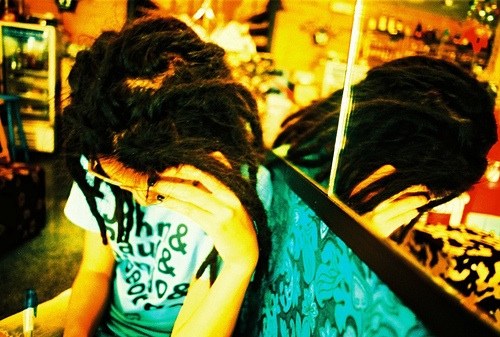
17 May A Nation of Nattys and the Rastas in Between
My sistren’s locks are ebony black extensions from her soul. In a lazy, sexy bun they sit on her head, mirroring her ancestors of Africa. In celebration, they are sculptured offerings to nature and femininity.
My sistren’s locks, which are at least two feet long and over a decade old, make Rasta men forget H.I.M. and lust. My sistren, who owns her own natural hair salon, once laughed and nodded her head when another natural sista said, “Gyul, is not brushing meh hair that make me turn Rasta, oui!”, adding some time after, “fuh real”.
“Gyul, is not brushing meh hair that make me turn Rasta, oui!”, adding some time after, “fuh real”.
Pretty girls turned ras enjoy the privilege of being both ‘roots’ and eye candy…
In the beginning (of locks, not Creation), the term “dreadlocks” was just that, dread. Founding Rastafaris wore their head in dreadlocks as a sign of defiance against a predominantly white-ruled society aka Babylon. There was also religious confirmation, as the story of Samson gaining strength from his uncut locks, as well as the Nazirite vow in Numbers 6:5, “All the days of the vow of his separation there shall no razor come upon his head…”, became quotable scripture for those who forgo societal norms of grooming.
Even in the days of Bob Marley, Rastas all over the Caribbean were ostracized from their own families because of their locks.
In Geoffrey Philp’s “I Want to Disturb My Neighbour”, he recounts his boyhood days and his introduction to reggae and Rastafarianism. It is a story of his born-again Christian mother weaving woeful tales of a young man who has thrown his life away by converting to Rastafarianism. The son is thrust in the middle, as the messenger of the fearful Christians who, while they despise the Rasta man now living in their community, are too fearful to approach him personally. He is sent to tell the Rasta to turn down his (reggae) music, under the threat that his mother will inform the police that he is smoking marijuana. The Rasta in restrained anger submits to this request, not before explaining to the little boy that he doesn’t smoke, and that his mother’s Christian revivals are much more disturbing the community.
Philp sums up the acceptance of what was not acceptable:
“We accept the Rasta man today. We see him and his fashion victims all around – the colours, the music, the hair, and the food. But in those days in Jamaica, decent people like my mother thought of them as cells of infection that had to be cut out. They were spreading Africa throughout the body politic.”
In another paragraph, he extols the treatment of Rastas:
“How de policeman/ deal wid de rasta. / Trim hair. / Comb beard. /Crack skull. /Kick down. / Jump pon. / Beat up… lie.”
My own journey to nappy began over a year ago in my late twenties. Although for most of my life I lived in awe of dreads, admiring the way hair seemed to grow out of skulls like manes, and talking to Rastas who were my father’s routing partners in his early days – believing that they possessed an earthly understanding of divinity rather than my faith-driven Catholicism, I was afraid to lock my own hair. I did not understand how it worked. Did you just leave your hair to matte? How long would it take? What would it look like? Would I have to shave my head to get them out? When I finally made the decision, under the guidance of my loctician sistren, my father threatened expulsion from his house.
“I eh want no dreadlocks in my house!” he shouted.
After one cancelled appointment, I took the leap of faith and did it anyway. That was my first lesson in ‘locks’; like your hair a person must do what comes naturally. Nature has already chosen your course.
As the aesthetic appeal of locks grows, hopefully it will never lose its symbolism as defiance against the norm. Even the most elaborate up-do is just the butterfly stage in the metamorphosis of nappy hair to gorgeous coils, naturally grown. That is the true beauty in natty, the centre of the Rasta ideal, the connection between oneself and what is the natural being of man… and man’s hair.
About Quilin Achat
Quilin Achat is an avid lover of reading, so it's no surprise that she runs a small, unconventional bookstore called The Fire is Lit, in San Fernando. Check out the Fire is Lit at http://facebook.com/theFireisLit.
Twitter •


No Comments